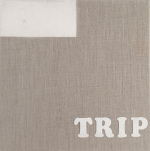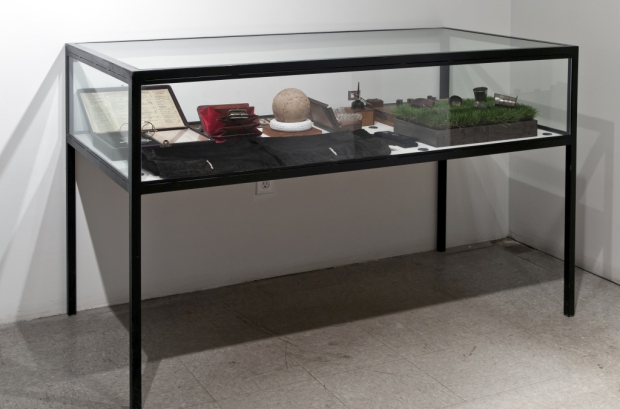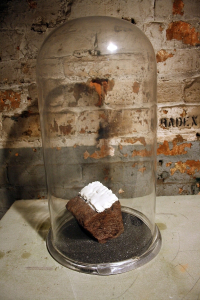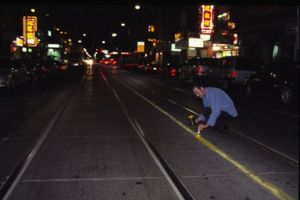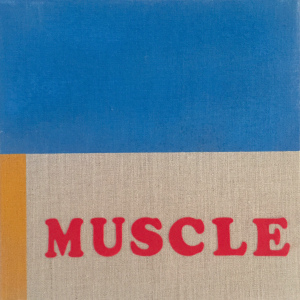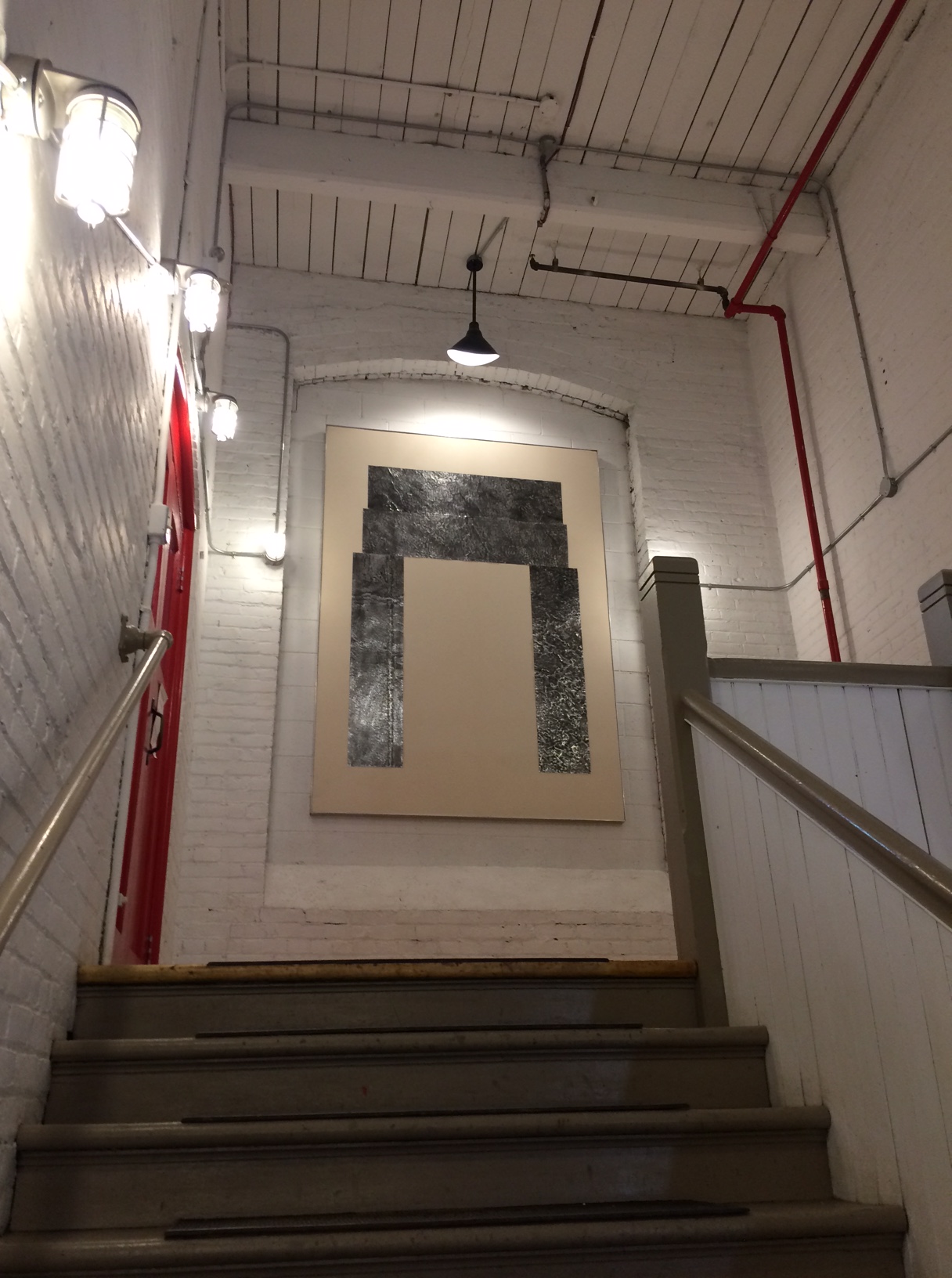by Shirley Madill
If one were to draw a line to define the work of C.Wells, I would describe it as having moved from complexity to simplicity, or when applied specifically to his most recent production, from the use of narrative structures to the physical representation of signs and symbols, which resume the polysemy of the meaning of the work of art. The construction of significances meticulously developed by C.Wells has remained fundamentally true to certain basic principles that shape his personal grammar. C.Wells denies art to evaluated solely by criteria associated with aesthetics and high art practice, but to be related to mental activity. This methodology is situated within the parameters that surround the making of a work of art as reflective of a timeless activity. Another way of understanding this is to see art as “becoming” rather than “being”.
Nietzsche has stated that the “effect of works of art is to excite the state that creates art – intoxication…Art and nothing but art! It is the great means of making life possible, the great seduction to life, the great stimulant of life.” In this context, it can be said that art itself is not to be grasped but to be taken up or caught, in the same way that surfers catching a wave merely insert themselves into a pre-existent flow of energy. Some artists feel as though their creativity originates beyond them, such as in a ‘muse’. It may be really an impulse of some sort that the artist picks up and directs into a work, and passes on to the viewer. With C.Wells, this may apply, but I am more struck by a quote by George Kubler that best describes Wells’ thinking. “A work of art”, writes Kubler in his book The Shape of Time, “transmits a kind of behavior by the artist, and it also serves, like a relay, as the point of departure for impulses that often attain extraordinary magnitudes in later transmission. Our lines of communication therefore originated as signals which become commotions emitting further signals in an unbroken alternating sequence of event, signal, recreated event, renewed signal, etc.”. Art is a matter of potential and kinetic energy. The artwork harbors a particular kind of invisible force.
The ‘line marker paintings’ of C.Wells are works that can be read as new treatises on art: treatises in which art no longer strictly focuses on the beautiful, the sublime or the aesthetic, but rather in a ‘space in between’. This space can be described as an area between the mental and the physical, an infinite sphere of existence within the demarcation – within the line of separation between work and viewer. I will explain this further.
Traditional aesthetics have always prioritized vision. For exmple, Nietzsche criticized Kant for having, “unconsciously introduced the ‘spectator’ into the concept of ‘beautiful’. The spectator’s aesthetics contrasted by Nietzsche to those of the creator, assume or create a gap between subject and object, a caesura, a viewing distance. In the concept of the sublime there is the threshold between subject and object. This is even more evident in the space of the museum where there is the artificial fabrication of a no ‘man’s’ land consisting of ‘DO NOT TOUCH’ murmurs to every passerby. In contrast, Wells removes this barrier, an invisibly drawn line between public and private, marking alternate points of contact that make it possible to form a circuit between the affective designs of painting and the receptors. Wells’ line marker paintings operate as conductors from the environment transmitting impulses from the efferent nerves of the artist to the viewer. Wells understands that art reflects the environment in which it is made, echoing in its condensed facets and symbolic traces the ethos and outlook of a time. Through art, unconscious processes can be elicited and some of the values can be discovered. In this respect, our human-made environments are also symbolic. Wells’ art addresses the elusiveness of these symbolic environments algebraically, with variables representing metaphorically the larger global environment – line marker paint. By using standard line marker paint, he creates visual messages that are subsequently decoded. It is not only these codes of representation that become the subject of this art, but also the codes themselves. The role of codification is important as a system of communication. These ‘painted’ codes are a replication of a larger system that are intuited and extracted from the environment. This methodology can also be addressed within the context of language.
Language is the most primary of human coding systems, and the most elusive, for the sources of language are unknown, yet it has evolved and externalized from utterances into visible codes that have come to emanate in a hardened-seeming dimension. From speech to hieroglyphs, writing, printing, neon signs, and preferences are agglutinated and accrued. In this process, the characteristics of what and how we know ourselves are shaped reshaped, determined and re-determined. Wells sees art as both a subset of language and a parallel system by which he transforms experience into forms that may (or may not) have linguistic affinities. Line marker paint, a utilitarian material that is used to paint on highways, contains its own referent, i.e. it is semiotic. Line markers communicate in a social public space. They define and regulate reading through their signification. They dictate distance and separation. Ironically Wells chooses line marker as the means to symbolically close the distance and address painting, painting history, painting in the world. The line marker is space, a created space, visually and mentally, of its own, no longer slid, but transmutable. Although its sign is intended to define the boundary and like language maintain social organization, its use in Wells’ art contains more affinities with that of graffiti.
Take for example the performative-based work, the hand loves that which is hard, where C.Wells painted over line markers in front of the Museum London, Ontario. A temporal work, done by hand (as opposed to machine), is unlike the work of Vancouver artist, R.Dick Trace-it who is known for ‘painting the town’ (sidewalks, stairs, streets) using dead body outlines. Wells’ purpose is not intervention or social comment. Rather his painting can be characterized more as generative code making involving a human synthesis of image – the line marker. What is essential is that a work of art has an individual order or coherence, a quality of unity and necessity in its structure regardless of the kind of forms used, and painting line marker paintings is the beginning of an order. It is a kind of order that in the end retains the aspect of the original ‘disorder’ as a manifestation of freedom. This is “becoming”.
As Kasmir Malevich’s contemporary Kruchenykh once said, “the artist is free to express himself not only in a common language…but also a private one…as well as in a language that does not have a definite meaning…that is trans-rational”. I cannot help but think of this statement in approaching a line marker painting by C.Wells witnessing how language can be freed from determination. In our attempts to “read” or “interpret” this work, we affirm our own radical disparity of experience. Such is the same in our attempts to decipher the coded meanings in tagging. Like graffiti art, these aren’t works that exist in a state of inert passivity. There is a condition of tension wherein two systems, the linguistic and the visual, are thrown together both asserting their difference even as they interact.
Handicap/Blue Boy and Handicap Blue/Boy reveal the semiotic and semantic nature of Wells’ methodology. Using the blue line marking paint associated with handicapped parking areas, he draws on the relationship between art and public sphere. Thomas Gainsborough’s famous painting known as the Blue Boy, described as ‘the most popular picture in English painting’ has been scanned and giclé printed. Next to it is a minimalist panel where a field of colour using line marker paint, “Handicap Blue” has been applied to a canvas of equal proportion. Both works are known by their colour. Throughout history, colour has been known to contain symbolic meanings that are social, cultural and geographical. Line marker paint defies North American highways. In his paintings, Wells weighs equally the semiotic and semantic – the two components acting as a bridge to the world. At the same time, he ironically plays with the idea of consumerism and the anti-aesthetic, choosing to utilize civic created colour and an image of art associated with mass production and social class.
Carrying the idea further, works such as Two Ways of Achieving an End, Interior/Exterior, A to B (the Bernie Moore piece) and the propensity to speak too soon use yellow, black and white line marker paint. These works, in some cases using double lines and alternating strips of colour, coincide to more optical conditions found in the landscape. C.Wells’ work resonates with ideas formulated in early Conceptualist, performative and Dadaist art. Stepping outside of representation with its myth of truth to the natural world, his language is a metaphor visualized in his art-object. (I use the word “object” loosely in this context). Even his name is a phonetic pun for “see well”. His disavowal of representation and the aesthetics of abstraction characterize a “breaking free” by stimulating our perceptions through new means of interaction. Line marker paintings chart a new journey by the creation of a new site of engagement. The displacement of the material of line marker paint – from the street to the studio to the gallery is not a simple change of environment – it is a mental transport. His refusal of the authoritative, his declaration of reversibility is a repudiation of established logic.
Like Marcel Duchamp, C.Wells’ work embraces a double language with its union of possibilities and heterogeneity. These are works that are not visual renditions of a single meaning. They are not firm, enclosed works produced by a self-absorbed individual. Rather they are grounded within the hypothesis of space that engages us mentally. Marcel Duchamp was also interested in the creative process as much as the object. What distinguishes the appropriated component in Wells’ art is his intent of an integration of unconscious and conscious processes. Like Duchamp, he exemplifies the intellectual side of art’s metaphysics and the idea that the use of something in our environment is a way to transform meaning. By extension, he also stresses how the fundamental attributes of art are to be found in the framing of a quality of thought and a quality of sight, reflecting the transformative act where an idea is presented as an object.
If there is one factor that has determined the character of painting in the past century it can be recognized in the way that artists have negotiated a line between idea and the realization of idea as image, the embodiment of creative transformation. Wells’ painting embodies two extremes. At one extreme there is a concern for the reification of meaning with the invariable mute surfaces of a process that givens an appearance to painting that is resolutely non-figurative, and yet has to figure content, still carry and project meaning. Alternatively, there is the desire to make images that are both about painting and about that paint’s transference of subject and meaning to a subject that can also enact a discourse whose site is far from the palette and surface of the painting.
What is figured in C.Wells’ painting discourse is an idea. It is not the figuration of painting itself nor a figured image. Each line marker template is constructed and could be said to be the result of an already determined internal logic. Although their subject and origin resides in this logic of construction, the content makes contact with the mystery that occurs when an idea is transformed and realized as an object – a line marker painting. Wells’ art is not only about its making. There is the separation between his subject and the quality of making and seeing, just as there is a gap that has to be bridged when an idea is presented as object. Sited in the gap, which I refer to as line marker’s territory (C.Wells’ territory) is the realization of idea as image. Questions are raised concerning content. The act of making meaning becomes directed, not at the external form of something, but an internal structuring of language. These paintings go far beyond the usual perception of the problem pf painting but rest in the complexities pf contemporary experience. Wells approaches painting differently, towards an aestheticization of “everyplace and nonplace”. This decentering or dislocation of the work of art’s signification constitutes a distinguishing characteristic of C.Wells’ work, and its construction works to support its destabilization.
Shirley Madill is currently director of the Art Gallery of Greater Victoria


